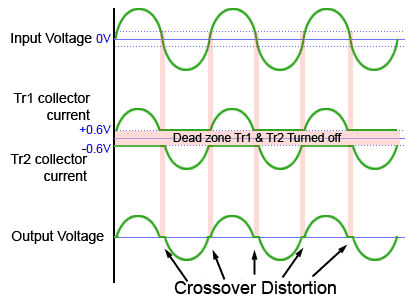Q.1. What is the major limitation of class B power amplifier & how to overcome the same?
Ans:
In class B amplifier, there is no standing bias current (the quiescent current is zero) and therefore the transistor conducts for only half of each cycle of the signal waveform. This dramatically increases efficiency, compared with class A.
The disadvantage of the increased efficiency is that the transistor only amplifies half the waveform, therefore producing severe distortion. However, if the other half of the waveform can be obtained in some other way without too much distortion, then class B amplifiers can be used to drive most types of output device. The aim is to obtain a good power gain with as much of the energy consumed from the power supply going into the load as possible.
The main problem with class B push pull output stages is that each transistor conducts not for a total half a cycle.
As shown in Fig, distortion occurs on each cycle of the signal waveform as the input signal waveform passes through zero volts. Because the transistors have no base bias, they do not actually begin to conduct until their base/emitter voltage has risen to about 0.6V. As a result, there is a ‘Dead Zone’ of about 1.2V around the zero volts line (between −0.6V and +0.6V) where the signal waveform is not amplified, causing a “missing” section from the output signal, resulting in unwanted distortion during the “crossover” from one transistor to the other.

The effect of this distortion on the output depends to some degree on the amplitude of the output signal, the larger the amplitude the less significant the missing 1.2 volts becomes. Also the distortion will be less severe at high frequencies where the rate of change of the wave, as it passes through zero is much faster, causing a shorter ‘step’ in the waveform.
Crossover distortion is more of a problem in low and medium power class B amplifiers and the method used to eliminate it, is to use a class B amplifier that has some bias (and quiescent current) added so that the output transistors are conducting continually, and so avoiding the ‘dead zone’ of class B. As this method has some properties of both class A and class B it is called Class AB.
